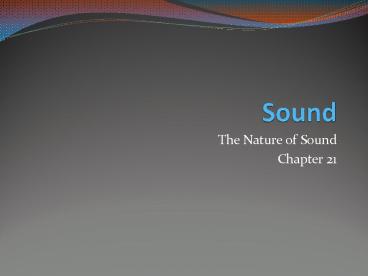Sound - PowerPoint PPT Presentation
1 / 22
Title:
Sound
Description:
The Nature of Sound Chapter 21 Objectives: Physical Standard 1 I will be able to describe sound wave characteristics that are common among other forms of waves. – PowerPoint PPT presentation
Number of Views:110
Avg rating:3.0/5.0
Title: Sound
1
Sound
- The Nature of Sound
- Chapter 21
2
Objectives
- Physical Standard 1
- I will be able to describe sound wave
characteristics that are common among other forms
of waves. - I will be to differentiate unique characteristics
of sound. - THINK Why is sound important?
3
Close Your Eyes and Listen
Click
Click
Click
Click
Click
Click
4
- Sound waves
- Interactions
- of sound
- Reflection
- travels through a medium (solid, liquids or
gases) - longitudinal wave
- Sound travels by sending vibrations -back and
forth motion - through matter - Pair and Share Why cant you hear sound in
outer space? How do they communicate with each
other? - reflected sound called an echo
- hard, smooth surface stronger reflection
5
Reflection
Sound Waves
6
REVIEW WAVE
- Bending of sound waves as it passes from one
medium to another - Bending of waves around a barrier
- sound waves meet
- constructive? increases sound
- destructive? decreases sound
- at room temp, sound travels at 343 m/s
- speed depends on medium it travels though
- Refraction
- Diffraction
- Interference
- Illustrate the three above
- Speed of Sound
7
Mediums and Sound
- more elastic a medium? faster sound travels
- Solid fastest speed
- Liquid medium speed
- Gas slow speed
- Vacuum no sound
- sound travels slower in dense materials
- sound travels slower at lower temperatures and
higher altitudes - Pair and Share Why does this happen?
- Elasticity
- Density
- Temperature
8
Properties of Sound
- describes your perception of the energy of a
sound - describes what you hear
- depends on 2 factors
- energy of sound source
- distance from sound source
- The Coolest Things Sound Wave Can Do
- Find someone and share video
- Loudness
9
- Energy of a sound source
- Think Draw an example
- Distance from a sound source
- Think Draw an example
- greater energy used ? louder sound
- more energy ? greater amplitude (vibration)
- large amplitude ?loud sound
- loudness increases the closer you are to a sound
source
10
- amount of energy a sound wave carries per second
through a unit area - greater intensity sounds louder
- unit decibel (dB)
- sound barely heard 0 dB
- sound louder than 100 dB can damage ears
- Intensity
- Measuring
- Loudness
11
(No Transcript)
12
- Pitch
- Pitch
- Frequency
- Pitch and Frequency Video
- description of how high or low the sound seems to
a person - depends on frequency of the wave
- high frequency ? higher pitch
- low frequency ? low pitch
- can hear sounds with frequency between 20 Hz and
20,000 Hz
13
- Ultrasound
- Infrasound
- Doppler Effect
- sound waves with frequency above normal human
range - frequency below human range of hearing
- change in frequency of a wave as its source moves
in relation to an observer - change in frequency is heard as a change in pitch
14
(No Transcript)
15
- Shock Waves
- Sound Quality
- shock waves form as sound waves overlap
- release huge amounts of energy
- sonic boom heard when they pass by
- Blending of several pitches through interference
16
- Noise
- Music
- Random mix of frequencies that are
- not pleasing
- set of frequencies that combine in patterns that
are pleasing
17
How you Hear Sound
- function gather sound waves and send info to
brain - three main sections outer, middle, inner
- collects sound waves and directs them to ear
canal which vibrates eardrum
- Human Ear
- Outer Ear
18
- Middle Ear
- Inner Ear
- contains 3 small bones that increase size of
vibrations - Vibrations are changed into electrical signals
for the brain to interpret
19
(No Transcript)
20
- can occur if eardrum is damaged
- loud sounds can damage hair cells in inner ear?
wont get messages to brain - old age? hair cells gradually die? harder to hear
- amplify sound
- Hearing Loss
- Hearing Aids
21
- -use of reflected sound waves to determine
distances or locate objects - -animals use this to navigate and find food ?
Bats, dolphins
- Echolocation
22
(No Transcript)































